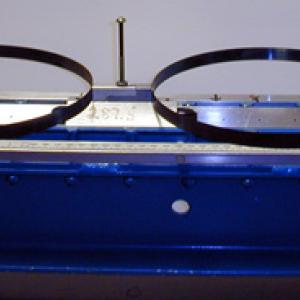College of Liberal Arts & Sciences
3A75.10 - Coupled Oscillations - Air Track
Set the air track level and then couple the desired gliders together with the springs. If using 5 gliders, set the end stop at 1.50 meters. If using 6 gliders, set the end stop at 1.75 meters. Clamp the mechanical oscillator unit to the air inlet end of the air track. Set the frequencey generator to the 10 Hz. scale. The mechanical oscillator unit has a limited range of motion so you only need to turn up the amplitude on the frequency generator until that is maxed out. Adding more amplitude will only risk blowing the fuse in the unit. There is a a glider tie down which can be used to quickly clamp a glider directly to the air track so that you can easily go from N = 1 to N = 6 gliders without having to add or remove gliders or springs. Modes of each N number of gliders and their approximate frequencies are:
N = 1, .836 Hz
N = 2, .582 Hz ← ← , 1.004 Hz → ←
N = 3, .438 Hz → → → , .823 Hz → 0 ← , 1.075 Hz → ← →
N = 4 , .35 Hz → → → → , .69 Hz → → ← ← , .93 Hz → ← ← → , 1.10 Hz → ← → ←
N = 5, .295 Hz → → → → → , .59 Hz → → 0 ← ←, .82 Hz → 0 ← 0 → , 1.0 Hz → ← 0 → ← , 1.25 Hz → ← → ← →
N = 6, .255 Hz → → → → → → , .495 Hz ← ← ← → → → , .720 Hz → → ← ← → → , .900 Hz → ← ← → → ← , 1.050 Hz → ← → → ← → , 1.135 Hz → ← → ← → ←
You can also use the hoop springs for this demonstration. You may have to add the special "horseshoe" adapters at the ends of the chain depending on the set up desired.
- Antonino Carnevali and Cynthia L. Newton, "Coupled Harmonic Oscillators Made Easy", TPT, Vol. 38, # 8, Nov. 2000, p. 503.
- Norris W. Preyer, "The Coupled Harmonic Oscillator", TPT, Vol. 34, # 1, Jan. 1996, p. 52.
- Shulamith G. Eckstein and Dan Fekete, "Investigation of Driven Harmonic Oscillations in the Computerized Student Laboratory", AJP, Vol. 59, #5, May 1991, p. 398.
- David L. Wallach, William Beatty, Karl Beisler, Peter Chronowski, Matthew Holloway, Robert Hutchinson, Diane Kacmarik, Raymond Lesko, James Lutz, Daniel Miller, and Michael Sivak, "The Effect of the Mass of the Center Spring in One-Dimensional Coupled Harmonic Oscillators", AJP, Vol. 56, # 12, Dec. 1988, p. 1120.
- P. E. Quellette, "Mutual Inertia", AJP, Vol. 46, # 3, Mar. 1978, p. 237.
- R. B. Runk, J. L. Stull, O. L. Anderson, "A Laboratory Linear Analog for Lattice Dynamics", AJP, Vol. 31, #12, Dec. 1963, p. 915.
- Mx-14: Freier and Anderson, A Demonstration Handbook for Physics.
Disclaimer: These demonstrations are provided only for illustrative use by persons affiliated with The University of Iowa and only under the direction of a trained instructor or physicist. The University of Iowa is not responsible for demonstrations performed by those using their own equipment or who choose to use this reference material for their own purpose. The demonstrations included here are within the public domain and can be found in materials contained in libraries, bookstores, and through electronic sources. Performing all or any portion of any of these demonstrations, with or without revisions not depicted here entails inherent risks. These risks include, without limitation, bodily injury (and possibly death), including risks to health that may be temporary or permanent and that may exacerbate a pre-existing medical condition; and property loss or damage. Anyone performing any part of these demonstrations, even with revisions, knowingly and voluntarily assumes all risks associated with them.
